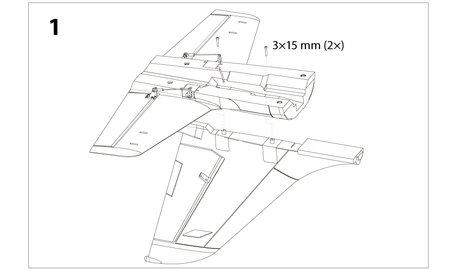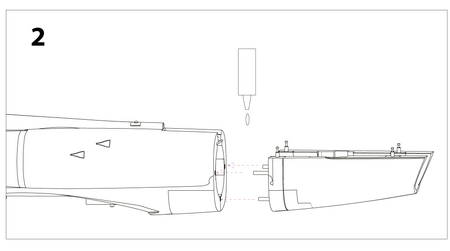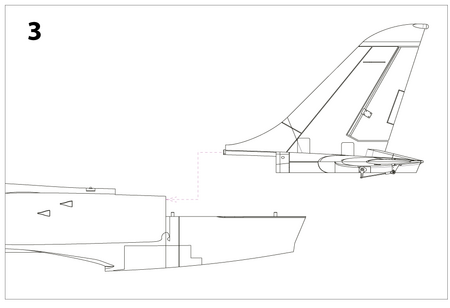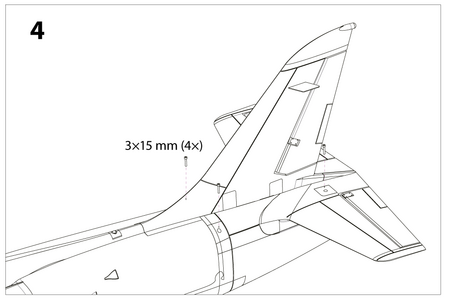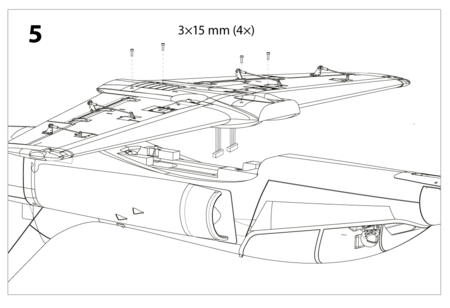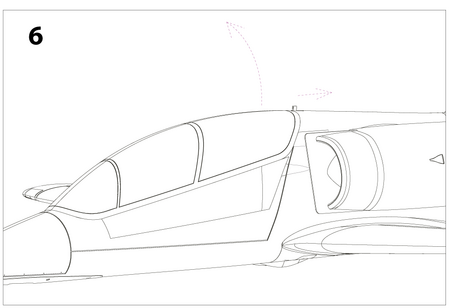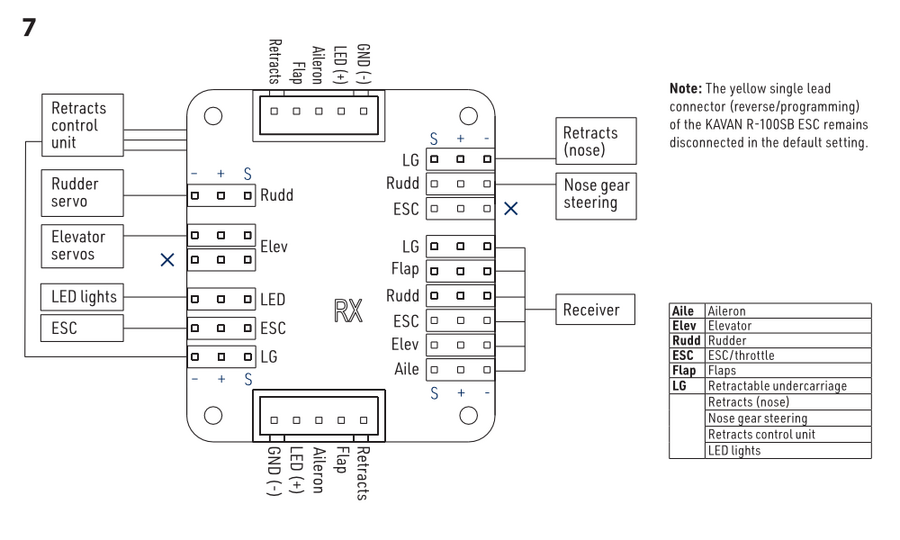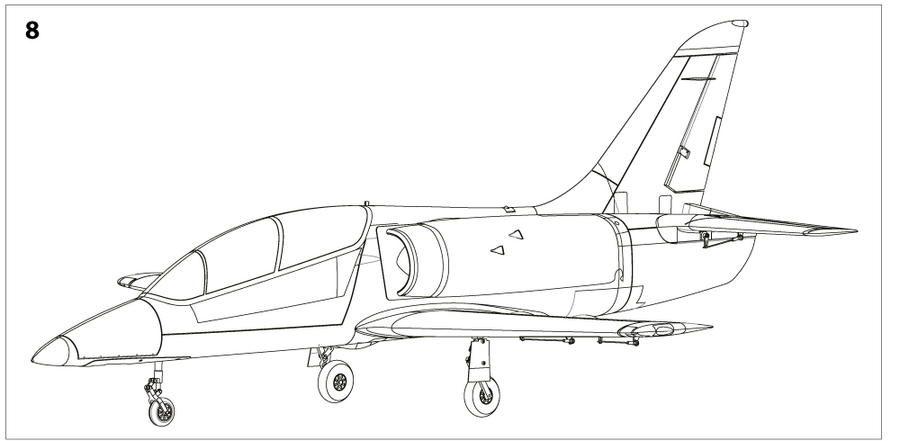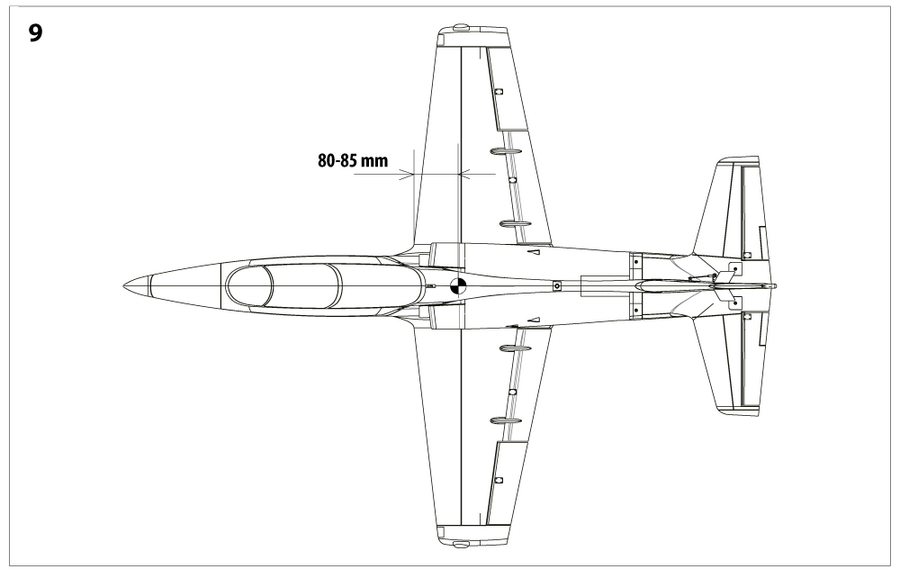KAVAN L-39 Skyfox 1088mm - Bauanleitung
Einführung
Herzlichen Glückwunsch zum Kauf des Semiscale-Modells des tschechischen militärischen Übungs-Strahlflugzeuges und leichten Kampfflugzeuges Aero L-39 Skyfox. Sie sind Besitzer eines nahezu unzerbrechlichen Schaumstoffmodells aus EPO (extrudiertes Polyolefin) geworden, das mit einem leistungsstarken Brushless-Motor angetrieben wird und von LiPo Akkus versorgt wird. Jeder, der bereits weiß, wie man ein schnelles und wendiges Modell fliegt, wird das Steuern dieses eleganten Semiscale-Modells genießen!
Aero L-39 Skyfox
L-39 Skyfox ist ein militärisches Übungs-Strahlflugzeuge und leichtes Kampfflugzeug, das von der tschechischen Firma Aero Vodochody AERO Vodochody AEROSPACE a.s. entwickelt wurde und hergestellt wird. Es ist der Nachfolger des legendären Flugzeugs L-39 Albatros. L-39 Skyfox behält zwar das erfolgreiche Grundkonzept seines Vorgängers bei, hat aber eine komplette Neukonstruktion mit Komposit-Materialien, einem modernen Zweiwellen-Turbofantriebwerk und der neuesten Avionik einschließlich HUD-Displays. Der neue „nasse“ Flügel mit dem integralen Kraftstofftank macht Skyfox auf den ersten Blick erkennbar - die charakteristischen Flügelspitzentanks von Albatros sind nicht mehr vorhanden. L-39 Skyfox wird vom sparsamen Zweiwellen-Turbofantriebwerk Williams International FJ44-4M angetrieben, wodurch die Betriebskosten auf das Niveau von Turboprop-Trainingsflugzeugen gesenkt werden können. Fünf externe Befestigungspunkte unter dem Flügel und Rumpf können bis zu 1360 kg Last aufnehmen: 2 Zusatztanks, Container mit 12,7 mm-Maschinengewehren, 20 mm-Kanonen oder ungelenkten Raketen, 227 kg Bomben Mk. 82, lasergesteuerte Bomben GBU-12 Paveway, Trainingsraketen CATM oder selbstgesteuerte Kurzstrecken-Luft-Luft-Raketen AIM-9 Sidewinder, Container mit Aufklärungs-Ausrüstung usw. Die Serienproduktion von L-39 Skyfox hat im Mai 2023 mit Flugzeugen für die tschechische, ungarische und vietnamesische Luftwaffe be gonnen. Gleichzeitig läuft das Modernisierungsprogramm für die ursprünglichen L-39 Albatros mit Skyfox-Triebwerken und -Avionik. Die tschechischen Übungs-Strahlflugzeuge werden auch in den kommenden Jahren nicht vom Himmel verschwinden.
Technische Angaben
- Spannweite: 9,38 m
- Länge: 11,83 m
- Gewicht: 3 100 kg (Leergewicht), 5 600 kg (max. Startgewicht)
- Antrieb: Zweiwellen-Turbofantriebwerk Williams International FJ44-4M 16,86 kN
- Höchstgeschwindigkeit: 907 km/h oder 0,8 Mach
- Dienstgipfelhöhe: 10 670 m
- Flugbereich: 1 900/2 500 km (mit Zusatztanks)
- Maximale G-Belastung: +8/-4 G
Einzelheiten finden Sie unter: https://www.aero.cz/l-39-skyfox/
Vorsichtsmaßnahmen
- Dieses RC-Modell ist kein Spielzeug. Benutzen Sie es mit Vorsicht und befolgen Sie die Anweisungen in dieser Anleitung genau.
- Sie sich an die Anweisungen in dieser Anleitung. Bauen Sie das Modell gemäß der Anleitung zusammen. Modifizieren und verändern Sie das Modell nicht. Bei Nichteinhaltung erlischt die Garantie. Folgen Sie der Anleitung um ein sicheres und haltbares Modell nach dem Zusammenbau zu erhalten.
- Kinder unter 14 Jahren müssen das Modell unter Aufsicht eines Erwachsenen betreiben.
- Versichern Sie sich vor jedem Flug, dass das Modell in einwandfreiem Zustand ist, dass alles einwandfrei funktioniert und das Modell unbeschädigt ist.
- Fliegen Sie nur an Tagen mit leichtem Wind und an einem sicheren Platz ohne Hindernisse.
Bevor Sie beginnen
- Falls Sie kein erfahrener Pilot sind, nehmen Sie die Hilfe eines kompetenten Piloten in Anspruch um ihr zusammengebautes Modell zu überprüfen und bei den Erststarts zu helfen. Obwohl wir Ihnen eine vollständige Anleitung zur Verfügung gestellt haben, so ist ein Modellflugzeug ziemlich kompliziert und ein erfahrener Modellbauer kann schnell ihr Modell überprüfen und somit sicherstellen, dass ihre ersten Flüge erfolgreich werden.
- Bitte bauen Sie ihr Modell genau nach dieser Anleitung auf. Versuchen Sie nicht ihren Modell zu modifizieren oder zu verändern, da dies die Flugeigenschaften negativ beeinflussen kann.
- Bevor Sie beginnen prüfen Sie den Inhalt des Bausatzes auf Vollständigkeit und prüfen Sie, dass keine Teile beschädigt sind. Dies hilft auch sich mit den Teilen des Modells vertraut zu machen. Falls Teile fehlen oder beschädigt sind, so wenden Sie sich umgehend an ihren Händler.
- Versuchen Sie zuerst die Teile zusammenzufügen bevor Sie sie verkleben. Versichern Sie sich, dass sie die korrekten Teile benutzen und dass sie gut zusammen passen vor dem Zusammenbau. Auch viel Kleber kann schlecht passende Teile nicht zurecht machen.
- Die Anleitung zeigt die Standart Einstellung des Schwerpunktes. (CG) und empfohlene Ruderausschläge. Bitte berücksichtigen Sie, dass es wesentlich ist den empfohlenen Schwerpunkt beizubehalten für die ersten Flüge, ansonsten könnte das Modell unstabil und schwer zu fliegen sein, oder gar nicht fliegen. Sie können den Schwerpunkt später tunen um ihn an ihren Flugstil und ihr Können anzupassen.
Sicherheitsmaßnahmen und Warnungen
- Ein ferngesteuertes Modell ist kein Spielzeug! Es kann erhebliche Verletzungen und Sachbeschädigungen anrichten. Fliegen Sie nur an einem sicheren Ort und folgen Sie den Anweisungen und Empfehlungen dieser Anleitung. Bleiben Sie von der Luftschraube weg! Halten Sie lose Teile entfernt von der drehenden Luftschraube, damit sie nicht eingesaugt werden können. Dies schließt lose Kleidung, und andere Sachen wie Kugelschreiber und Schraubendreher mit ein. Gehen Sie sicher, dass ihre und andere Leute Hände und Gesicht vom drehenden Propeller weg sind.
- Als Betreiber des Modells sind Sie alleine verantwortlich für die sichere Anwendung, dass weder Sie noch andere verletzt werden, oder das Modell beschädigt wird, oder Schäden an anderen Sachen entstehen. Dieses Modell wird durch eine Funk-Fernsteuerung gelenkt deren Signal durch viele Dinge gestört werden können, die außerhalb Ihrer Kontrolle sind. Diese Störungen können vorübergehenden Verlust der Steuerbarkeit zur Folge haben und es ist deshalb ratsam eine sichere Entfernung in allen Richtungen um ihr Modell herum zu haben um Kollisionen und Verletzungen zu vermeiden.
- Betreiben Sie ihr Modell nie mit schwachen Senderbatterien.
- Betreiben Sie ihr Modell immer im offenen Gelände entfernt von Stromleitungen, Autos, Verkehr, Menschen. Betreiben Sie ihr Modell nie in bewohnten Gebieten.
- Beachten Sie exakt diese Anweisungen und Warnungen. Dies gilt auch für die zusätzliche Ausrüstung, die Sie einsetzen. (Ladegeräte, wieder aufladbare Akkus, usw.)
- Halten Sie alle Chemikalien, Kleinteile und jegliche elektrischen Teile außerhalb der Reichweite von Kindern.
- Feuchtigkeit verursacht Beschädigungen der Elektronik. Vermeiden Sie Wasser-Kontakt aller Teile, die nicht dafür ausgelegt oder dagegen geschützt sind.
- Das Modell ist mehrheitlich aus Kunststoff hergestellt. Es ist nicht feuerfest. Es darf nicht höheren Temperaturen ausgesetzt werden, ansonsten könnten Verformungen oder andere Beschädigungen auftreten.
Technical specifications
| Wingspan | 1080 mm |
| Length | 1369 mm |
| All-up weight | 2550–2750 g |
| Wing area | 25 dm² |
| EDF | 80 mm |
| Motor | C3552-2000KV |
| ESC | KAVAN R-100SB Plus |
Set contents
An almost ready-to-fly model with an 80mm EDF, brushless motor, speed controller and servos installed, instruction manual.
You will also need
- At least six channel RC set, 22.2 V 3700–5000 mAh LiPo at least 40C, 60C preferred, flight pack with the XT90 connector.
- Regular modeller’s tools - precision knife (KAV66.770), screwdrivers, pliers, 1.5 mm and 2.5 mm hex keys or screwdrivers etc.
- Glue: Medium or thick cyanoacrylate (e.g. KAV56.9952 or KAV56.9953), silicone or MS polymer glue.
Model assembly
- Secure the fin and rudder assembly with two 3×15 mm self-tapping screws to the upper tail fuselage/horizontal tailplane assembly. (Fig. 1)
- Glue the bottom tail part of the fuselage using medium or thick cyano, contact glue or MS polymer glue to the front part of the fuselage. (Fig. 2)
- Hook up the rudder (RUD) and elevator (ELE) servo extension cables; secure the connectors with a strip of sticky tape or heat shrink tube and then attach the tail assembly to the fuselage. (Fig. 3)
- Secure the tail assembly to the fuselage using four 3×15 mm self-tapping screws. (Fig. 4)
- Thread the wing servo extension cables into the cockpit; attach the wing to the fuselage and secure it with four 3×15 mm self-tapping screws. (Fig. 5)
- Pull the tab of the canopy lock back to release and remove the canopy. (Fig. 6)
- Hook up your receiver, servos and ESC following the wiring diagram (Fig. 7). The receiver is to be secured with a strip of double-sided foam tape or hook-and-loop tape to the rear part of the cockpit. Deploy the antennas so their active parts are square to each other (if you are using a receiver featuring diversity antennas).Note: The kit is supplied with the connection board for ailerons, flaps, elevator, rudder, retracts, ESC and LED lights so you can use even the most basic 6-channel radios to control your Skyfox. If you intend to use independent control of aileron and flap servos and an advanced computer radio, you will have to bypass the connection board accordingly. The LED lights are only powered via the connection board; they are not remotely controlled in any way.
- Attach the canopy back. The assembly of your model is finished. (Fig. 8)
RC set installation and preflight check
- Referring to the instruction manual of your radio, carefully hook up the onboard electronics.
- Once everything has been correctly connected, turn on your transmitter and plug in the flight pack. Check the neutral positions and throws of all control surfaces. If you need to make the control surface throws smaller, simply move the pushrod closer to the centre on the servo arm or move it far from the control surface on the control horn. And vice versa.
| Recommended throws | *Low rate | *High rate | ||
| Rate | Expo | Rate | Expo | |
| Ailerons | ± 12 mm | 25 % | ± 16 mm | 25 % |
| Elevator | ± 14 mm | 30 % | ± 20 mm | 30 % |
| Rudder | ± 21 mm | 30 % | ± 30 mm | 30 % |
| Flaps | Take-off: -26 mm down / Landing: -55 down | |||
| Flap → Elevator Mix | Take-off: 1 mm down elevator / Landing: 3 mm down elevator | |||
*) The "Low Rate" recommended control surface throws are suitable for a less skilled pilot and regular "scale-ish" flying. The "High Rate" setting allows an experienced pilot to explore the full capabilities of his model.
- Check the direction of rotation of the EDF. If incorrect, simply swap two of the three wires between the ESC and motor.
- Check the correct position of the centre of gravity (CG) – 80–85 mm behind the leading edge of the wing (in other words 125–130 mm behind the front edge of the wing moulding) (Fig. 9). Adjust the CG position by moving the flight pack - if you could not reach the recommended position, do not hesitate to add an appropriate amount of lead to the nose or tail. An extra couple of grams won’t spoil the flying characteristics - but the incorrect CG position is a killer.
- Fully charge your flight pack and transmitter batteries, check the proper function of your radio and perform the range check of your radio according to its instruction manual. The range has to be almost the same with the motor off and at full throttle (no more than a 10 % decrease is acceptable). DO NOT try to fly unless the range check is 100% successful.
Flying
- The test flying and fine-tuning is pretty much straightforward and there will be no surprise for an advanced pilot that is supposed to fly this model.
- The Skyfox is to be operated from a good modeller’s airfield. A smooth tarmac airstrip is strongly preferred.
- Before you get familiar with the model, we suggest using the "Take-off" flap setting both for the take-off and landing (refer to the table above).
- Do not forget please: An EDF-powered model does not fly like a sailplane, once the motor shuts down due to a discharged flight pack.
Appendix
KAVAN R-100SB Plus instructions
Please refer to the KAVAN Plus ESCs - Instruction manual.
Recycling and waste disposal note (European Union)

Electrical equipment marked with the crossed-out waste bin symbol must not be discarded in the domestic waste; it should be disposed of via the appropriate specialised disposal system. In the countries of the EU (European Union) electrical devices must not be discarded via the normal domestic waste system (WEEE - Waste of Electrical and Electronic Equipment, Directive 2012/19/EU). You can take your unwanted equipment to your nearest public collection point or recycling centre, where it will be disposed of in the proper manner at no charge to you. By disposing of your old equipment in a responsible manner you make an important contribution to the safeguarding of the environment!
EU declaration of conformity (European Union)

Hereby, KAVAN Europe s.r.o. declares that the model L-39 Skyfox and the included electronic and electric devices are in compliance with the requirements of relevant European directives and harmonized norms. The full text of the Declaration of Conformity is available at http://www.kavanrc.com/doc/.
Guarantee
The KAVAN Europe s.r.o. products are covered by a guarantee that fulfils the currently valid legal requirements in your country. If you wish to make a claim under guarantee, please contact the retailer from whom you first purchased the equipment. The guarantee does not cover faults which were caused in the following ways: crashes, improper use, incorrect connection, reversed polarity, maintenance work carried out late, incorrectly or not at all, or by unauthorised personnel, use of other than genuine KAVAN Europe s.r.o. accessories, modifications or repairs which were not carried out by KAVAN Europe s.r.o. or an authorised KAVAN Europe s.r.o., accidental or deliberate damage, defects caused by normal wear and tear, operation outside the Specification, or in conjunction with equipment made by other manufacturers. Please be sure to read the appropriate information sheets in the product documentation!
